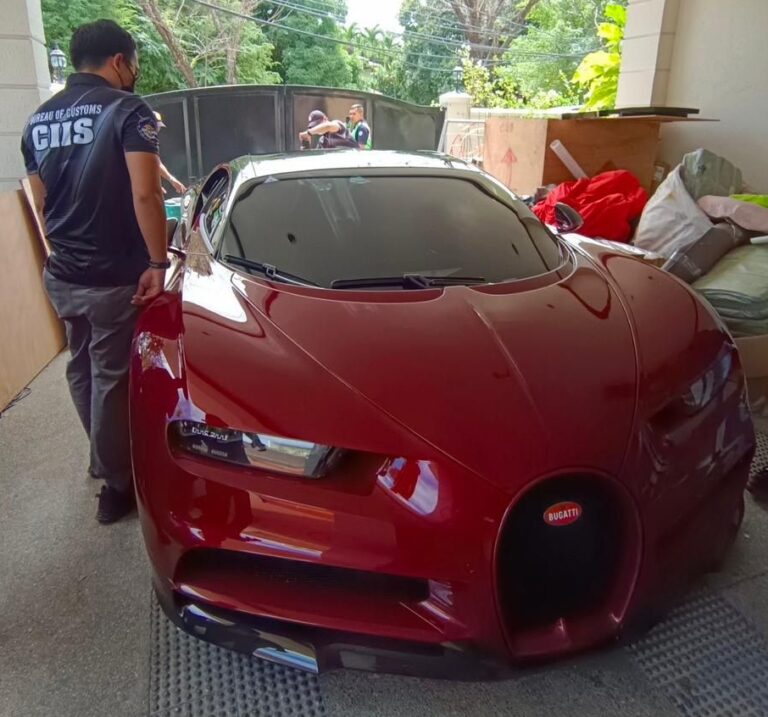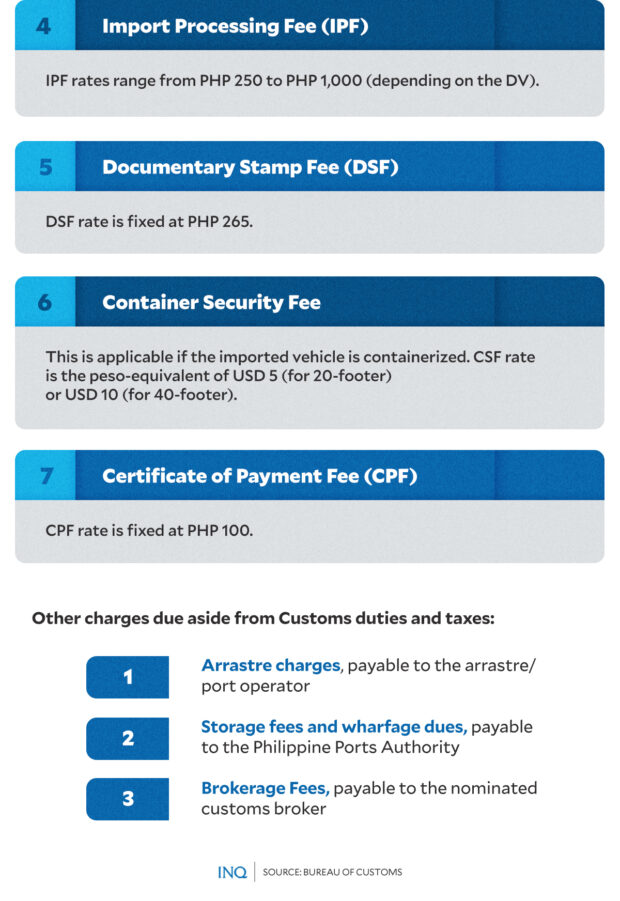Fancy a Bugatti Chiron? P365M per if legally imported
MANILA, Philippines — As lawmakers investigate the scandal involving two allegedly smuggled Bugatti Chiron sports cars, one pressing question emerges: What is the real cost of importing luxury cars into the Philippines?
The Bugatti Chiron is one of the most expensive cars in the market worldwide, pegged at around $3 million or, according to estimates by the Bureau of Customs (BOC), around P165 million per car.
Aside from its very hefty price tag, exclusivity, and limited production, the luxury car is only available to a selected few in the Philippines since it is not yet readily available for sale in the country through official channels.
The Bureau of Customs says that the owner of the red Bugatti Chiron sports car worth P165 million surrendered the luxury vehicle on Friday, Feb. 9, 2024. It was in Ayala Alabang Village in Muntinlupa City. (Photo courtesy of the BOC)
For those who can afford it, luxury cars that are yet to be officially sold in the country, such as the Bugatti Chiron, can be legally bought and imported through authorized importers or companies that are permitted by car manufacturers to sell their cars.
According to the BOC, imported motor vehicles — whether brand new or used — are subject to payment of Customs duties, taxes, and other charges.
However, outright smuggling of luxury items, such as cars, continued to persist in the country.
The hunt continues
The BOC is currently on the hunt for the second of the two Bugatti Chirons that went viral on social media after they were seen speeding along the streets of Metro Manila and Cavite province.
Last February 9, Tru Thrang Nguyen, the alleged owner of one of two high-end sports cars, surrendered a red 2023 Bugatti Chiron bearing the license plate NIM-5450 to the Customs Intelligence and Investigation Service (BOC-CIIS) at the Manila International Container Port. It had been parked in a residence in Ayala Alabang, Muntinlupa, a posh subdivision.
READ: Owner of smuggled luxury car surrenders vehicle to BOC
The other vehicle, a blue 2023 Bugatti Chiron with the license plate NIM-5448, is still out there and has yet to be surrendered by its purported owner, whom the BOC identified as Menguin Zhu.
The nationalities of the Bugatti owners have not been determined.
According to Customs Commissioner Bienvenido Rubio, the agency has information on the location of the car, but they are still verifying it.
READ: BOC tells owner of other smuggled Bugatti car to surrender
The BOC said it first received word of the alleged smuggled vehicles in November 2023, and it was found that the rare and ultra-pricey cars did not have the proper legal documentation.
Duties and taxes
Motor vehicles imported from other countries are subject to the following fees:
- customs duty: This is based on the Dutiable Value (DV) of the imported vehicle. The rate depends on the type of vehicle. For automobiles, BOC said the applicable rate is either 20 percent (for 10-seater or above) or 30 percent (for 9-seater or below).
- ad valorem tax (AVT): This applies only to automobiles. The rate is generally based on the landed cost (LC), except brand new automobiles consigned to car dealers or manufacturers.
- Value Added Tax (VAT): The rate is 12 percent for automobiles based on the sum of landed cost (LC) and the AVT. For other vehicles, the rate is 12 percent based on the LC.
- import processing fee (IPF): The IPF rates range from P250 to P1,000, depending on the DV.
- documentary stamp fee (DSF): The rate is fixed at 265
- container security fee: This is applicable if the imported vehicle is containerized. CSF rate is the peso-equivalent of $5 (for a 20-footer) or $10 (for a 40-footer).
- certificate of payment fee (CPF): The CPF rate is fixed at P100.
Other non-Customs charges imposed on imported vehicles include:
- arrastre charges: payable to the arrastre or port operator.
- storage fees and wharfage dues: payable to the Philippine Ports Authority (PPA).
- brokerage fees: payable to the nominated Customs broker.
Under the TRAIN law, automobiles worth up to P600,000 have a tax rate of 4 percent. For automobiles worth more than P600,000 but below P1 million, the tax rate is 10 percent while it’s 20 percent for automobiles above P1 million but below P4 million.
For automobiles with a price tag that is above P4 million — such as the allegedly smuggled Bugatti Chiron — the tax rate is 50 percent.
How much should it cost?
Senator Raffy Tulfo, in a privilege speech delivered during a plenary session last week, revealed that the two Bugatti Chiron sports cars had no prior record in the BOC, which indicated that they had been smuggled.
“[W]hen I asked in November if the owners had paid Customs duties, the senior Customs officials immediately answered that they had no record of these two Bugattis. They confidently told me that they looked at the records from 2019 onwards, and they said there were none,” said Tulfo.
READ: Sen. Tulfo wants deeper probe into alleged smuggling of Bugatti cars
Tulfo added that both owners paid only P24.7 million each for the Bugatti Chiron, which could indicate that luxury vehicles are being widely smuggled into the country without payment of the appropriate tax.
“We will see that someone can find a way to import luxury vehicles without paying the appropriate tax. According to the questionable Certificate of Payment submitted to the LTO, only P24.7 million was paid by each Bugatti owner,” Tulfo explained.
“But if this is computed, the estimated duties and taxes that should have been collected by the government is more than P207 million per Bugatti,” he continued.
The lawmaker said the Philippine government may have lost a total of P366 million if the Bugatti cars had, indeed, been smuggled.
Excluding some of the fees listed by the BOC and the non-customs fees, INQUIRER.net — with the help of ChatGPT — calculated the estimated cost of importing a Bugatti Chiron into the country.
The calculation used the following hypothetical values:
- cost of each of the Bugatti Chiron: P165,000,000 (according to BOC)
- shipping and insurance: $50,000 (P2,500,000)
- customs duty: P45,000,000
- VAT: P23,700,000
- excise tax: P75,000,000
Based on the assumptions and calculations provided, the estimated total cost of a Bugatti Chiron, when legally imported into the country, would be approximately P325,540,000 —around 97.30 percent, or P160,540,000, higher than the initial value of the car.
Another luxury car brand that is not yet readily available in the country is Cadillac. In April 2023, however, General Motors reportedly applied to trademark Cadillac through the Intellectual Property Office of the Philippines.
The most expensive model offered by Cadillac as of April last year was the Escalade ESV Platinum edition, priced at $100,000 or about PHP 5,000,000 (assuming an exchange rate of PHP 50 to $1) or higher depending on the level of customization and optional features selected.
The total estimated cost to import the Cadillac Escalade ESV Platinum would be approximately P8,644,000 based on the following assumptions:
- customs duty: P1,575,000
- value-added tax (VAT): P819,000
- excise eax: PHP 1,000,000
- shipping and insurance fees: P250,000
However, the actual costs of importing a Bugatti Chiron or the Escalade ESV — as well as other luxury car brands and models — may vary due to changes in tax rates, currency exchange rates, and specific fees at the time of import.
It’s advisable to consult with the BOC by sending an email to [email protected] or a professional Customs broker for accurate and up-to-date information.
Punishment and penalties
According to Rubio, the agency already has information on the location of the blue Bugatti Chiron, but they are still verifying it.
“Surrender, or you will face the consequences,” Rubio said, addressing himself to Zhu, the owner of the blue Bugatti.
“We already have the information on the location of the car, but we are still verifying this. But for the owner, it would be better for him to surrender, similar to what the owner of the red Bugatti did yesterday,” he said.
Owners of the vehicles would be asked to present proper importation documents. But if they fail to do so, they may face charges for violation of Section 1400 in relation to Section 1113 of the Customs Modernization and Tariff Act (Republic Act No. 10863).
Tulfo questioned the identities of the Bugatti owners, stressing that the Bureau of Immigration did not have any record, either, of their entry or exit in the Philippines.






